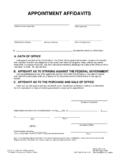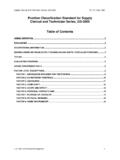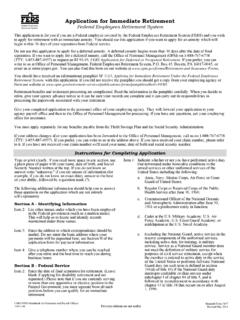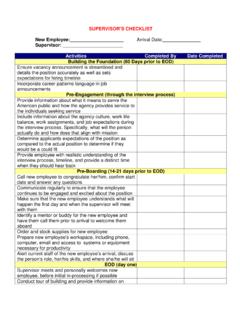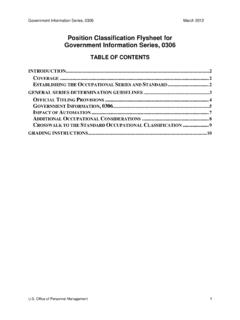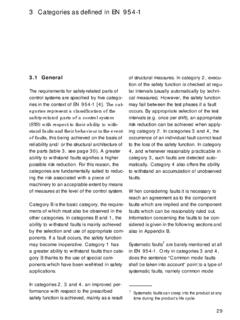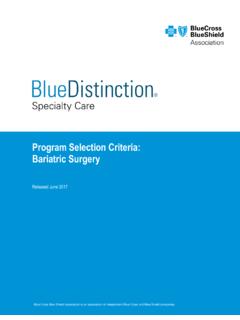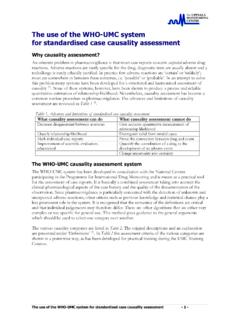Transcription of OPM/GOVT 10 SYSTEM NAME
1 OPM/GOVT 10 SYSTEM name : Employee Medical File SYSTEM Records. SYSTEM LOCATION: a. For current employees, records are located in agency medical, personnel, dispensary, health, safety, or other designated offices within the agency, or contractors performing a medical function for the agency. b. For former employees, most records will be located in an Employee Medical Folder (EMF) stored at the National Personnel Records Center operated by the National Archives and Records Administration (NARA). In some cases, agencies may retain for a limited time ( , up to 3 years) some records on former employees. Note 1: The records in this SYSTEM of records are owned by the Office of Personnel Management (OPM) and should be provided to those OPM employees who have an official need or use for those records. Therefore, if an employing agency is asked by an OPM employee to access the records within this SYSTEM , such a request should be honored.
2 categories OF INDIVIDUALS COVERED BY THE SYSTEM : Current and former Federal civilian employees as defined in 5 2105. categories OF RECORDS IN THE SYSTEM : Records maintained in this SYSTEM include: a. Medical records, forms, and reports completed or obtained when an individual applies for a Federal job and is subsequently employed; b. Medical records, forms, and reports completed during employment as a condition of employment, either by the employing agency or by another agency, State or local government entity, or a private sector entity under contract to the employing agency; c. Records pertaining and resulting from the testing of the employee for use of illegal drugs under Executive Order 12564. Such records may be retained by the agency ( , by the agency Medical Review Official) or by a contractor laboratory. This includes records of negative results, confirmed or unconfirmed positive test results, and documents related to the reasons for testing or other aspects of test results.
3 D. Reports of on-the-job injuries and medical records, forms, and reports generated as a result of the filing of a claim for Workers' Compensation, whether the claim is accepted or not. (The official compensation claim file is not covered by this SYSTEM ; rather, it is part of the Department of Labor's Office of Workers' Compensation Program (OWCP) SYSTEM of records.) e. All other medical records, forms, and reports created on an employee during his/her period of employment, including any retained on a temporary basis ( , those designated to be retained only during the period of service with a given agency) and those designated for long-term retention ( , those retained for the entire duration of Federal service and for some period of time after). f. Records resulting from participation in agency-sponsored health promotion and wellness activities, including health risk appraisals, biometric testing, health coaching, disease management, behavioral management, preventive services, fitness programs, and any other activities that could be considered part of a comprehensive worksite health and wellness program.
4 Note 2: Records maintained by an agency dispensary are included in this SYSTEM only when they are the result of a condition of employment or related to an on-the-job occurrence or result from participation in an agency-sponsored health and wellness program. Note 3: Records pertaining to employee drug or alcohol abuse counseling or treatment, and those pertaining to other employee counseling programs conducted under the Health Service Program established pursuant to 5 chapter 79, are not part of this SYSTEM of records. Note 4: Only Routine Use u identified for this SYSTEM of records is applicable to records relating to drug testing under Executive Order 12564. Further, such records shall be disclosed only to a very limited number of officials within the agency, generally only to the agency Medical Review Official (MRO), the administrator of the agency Employee Assistance Program, and any supervisory or management official within the employee's agency having authority to take the adverse personnel action against the employee.
5 AUTHORITY FOR MAINTENANCE OF THE SYSTEM : Executive Orders 12107, 12196, and 12564 and 5 chapters 11, 33, and 63. PURPOSE(S): Records in this SYSTEM of records are maintained for a variety of purposes, which include the following: a. To ensure that records required to be retained on a long-term basis to meet the mandates of law, Executive Order, or regulations ( , the Department of Labor's Occupational Safety and Health Administration (OSHA) and OWCP regulations), are so maintained. b. To provide data necessary for proper medical evaluations and diagnoses, to ensure that proper treatment is administered, and to maintain continuity of medical care. c. To provide an accurate medical history of the total health care and medical treatment received by the individual as well as job and/or hazard exposure documentation and health monitoring in relation to health status and claims of the individual.
6 D. To enable the planning for further care of the patient. e. To provide a record of communications among members of the health care team who contribute to the patient's care. f. To provide a legal document describing the health care administered and any exposure incident. g. To provide a method for evaluating quality of health care rendered and job-health-protection including engineering protection provided, protective equipment worn, workplace monitoring, and medical exam monitoring required by OSHA or by good practice. h. To ensure that all relevant, necessary, accurate, and timely data are available to support any medically-related employment decisions affecting the subject of the records ( , in connection with fitness-for-duty and disability retirement decisions). i. To document claims filed with and the decisions reached by the OWCP and the individual's possible reemployment rights under statutes governing that program.
7 J. To document employee's reporting of on-the-job injuries or unhealthy or unsafe working conditions, including the reporting of such conditions to OSHA and actions taken by that agency or by the employing agency. k. To ensure proper and accurate operation of the agency's employee drug testing program under Executive Order 12564. l. To facilitate communication among members of an on-site health and wellness program and to the individual employee participating in the program. m. To enable evaluation of the effectiveness of on-site health and wellness programs. ROUTINE USES OF RECORDS MAINTAINED IN THE SYSTEM , INCLUDING categories OF USERS AND THE PURPOSE OF SUCH USES: Note 5: With the exception of Routine Use u, none of the other Routine Uses identified for this SYSTEM of records are applicable to records relating to drug testing under Executive Order 12564. Further, such records shall be disclosed only to a very limited number of officials within the agency, generally only to the agency Medical Review Official (MRO), the administrator of the agency Employee Assistance Program, and the management official empowered to recommend or take adverse action affecting the individual.
8 These records and information in these records may be used: a. To disclose information to the Department of Labor, Department of Veterans Affairs, Social Security Administration, Federal Retirement Thrift Investment Board, or a national, State, or local social security type agency, when necessary to adjudicate a claim (filed by or on behalf of the individual) under a retirement, insurance, or health benefit program. b. To disclose information to a Federal, State, or local agency to the extent necessary to comply with laws governing reporting of communicable disease. c. To disclose information to another Federal agency, to a court, or a party in litigation before a court or in an administrative proceeding being conducted by a Federal agency when the Government is a party to the judicial or administrative proceeding. d. To disclose information to the Department of Justice, or in a proceeding before a court, adjudicative body, other administrative body before which the agency is authorized to appear, when: 1.
9 The agency, or any component thereof; or 2. Any employee of the agency in his or her official capacity; or 3. Any employee of the agency in his or her individual capacity where the Department of Justice or the agency has agreed to represent the employee; or 4. The United States, where the agency determines that litigation is likely to affect the agency or any of its components, is a party to litigation or has an interest in such litigation, and the use of such records by the Department of Justice or the agency is deemed by the agency to be relevant and necessary to the litigation, provided, however, that in each case it has been determined that the disclosure is compatible with the purpose for which the records were collected. e. To disclose in response to a request for discovery or for appearance of a witness, information that is relevant to the subject matter involved in a pending judicial or administrative proceeding.
10 F. To disclose pertinent information to the appropriate Federal, State, or local agency responsible for investigating, prosecuting, enforcing, or implementing a statute, rule, regulation, or order when the disclosing agency becomes aware of an indication of a violation or potential violation of civil or criminal law or regulation. g. To disclose information to the Office of Management and Budget at any stage in the legislative coordination and clearance process in connection with private relief legislation as set forth in OMB Circular No. A 19. h. To disclose information to a congressional office from the record of an individual in response to an inquiry from the congressional office made at the request of that individual. i. To disclose information to the Merit SYSTEM Protection Board or the Office of the Special Counsel, the Federal Labor Relations Authority and its General Counsel, the Equal Employment Opportunity Commission, arbitrators, and hearing examiners to the extent necessary to carry out their authorized duties.

